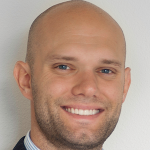Below, Nicholas Thompson shares five key insights from his new book, The Running Ground: A Father, a Son, and the Simplest of Sports.
Nicholas is CEO of The Atlantic. In his time as CEO, the company has seen record subscriber growth. Before this role, he was editor-in-chief of Wired magazine. He is also a former contributor for CBS News and has previously served as editor. As a runner, he set the American record for men 45+ in the 50K race.
What’s the big idea?
Running has the capacity to show us what we’re made of and help us grow beyond our limits—both as we race ahead on the track and in life. Struggle, aging, and even trauma can become engines of transformation if we learn how best to keep moving forward.
1. You don’t stop running because you get old.
You get old because you stop running. I used to think that you would just get better and better with age until you’re about 28, and then you would get worse and worse. But as I’ve gotten older, I’ve learned that isn’t true. In fact, I ran my fastest marathon at age 44.
Of course, there are certain things that decline in a runner’s life, as they do for everyone. Over the years, your bone density deteriorates, your VO₂ max goes down, and you’re more likely to get a little injured here or there. But while that happens, there are things that get better. We gain mitochondrial efficiency, for example, and most importantly, we get wiser.
We have learned more about training. We have learned more about our limits. And not only that, but we can also pick up new habits to do things differently. In some ways, aging is like you’re on a moving sidewalk that is going backwards, but you’re picking up things that allow you to go forward. If you can go the same speed forwards as you’re going backwards, then you run the same time year after year—which is what I did in my thirties. But sometimes, you can actually get better by going forward faster on that sidewalk than it’s pushing you backwards—and that’s what I did in my mid-forties.
This applies beyond running. I had this conversation with my mother recently: She’s in her mid-seventies, and she said, “Nick, my reflexes are just getting worse and worse with age.” I said, “There are things that are going to make your reflexes worse or worse with age, but what if we tried to go the other direction?” Then I got her out on our front porch and I started tossing her tennis balls, and she started catching them. I tossed them a little more to the side, and it turned out that her reflexes could get better.
Yes, aging is real. Unquestionably. There are many forces that slow us down, but what slows us down the most is when we give in and say, “I don’t want to do it today.” When that happens, that’s when you really start to slow down. That’s when you start to age. What you should do is push back as best you can.
2. Most pain is just a prediction.
When I was a young runner, I believed that pain was purely physiological. I would exercise, my body would produce lactic acid, and the lactic acid would somehow trigger fatigue or your muscles would micro-tear and that would trigger pain signals. But as I got older, I read more studies, thought more, read the work of people like Alex Hutchinson and Tim Noakes, and realized that pain is something quite different when you run a race.
Pain is weird. It moves all over the body. Maybe I’ll feel it in my calf and then my quad, and then I’ll feel like I have an upset stomach or I’m nauseous, or dizzy, or experience general malaise. Maybe my shoulder will hurt. What’s going on?
“Sometimes you must set an uncomfortable pace.”
It’s not that there’s actually something wrong in my quad and then my knees and then my stomach. This is my brain having a conversation with the rest of my body. The brain is worried about losing homeostasis. It doesn’t think that I can run this speed for this long. Maybe it doesn’t think I can run 26.2 miles on this hot day, at this particular speed, and so it’s trying to slow me down because it doesn’t want to enter a state where it could be at risk. During a race, pain is the brain trying to convince the body to slow down.
If that’s true, what does that mean about training? First, you should try to reset your brain’s expectations so that it doesn’t get so scared. When I’m in a marathon training cycle, I know that I can’t run every day as hard as I’m going to run on race day. But I try to stress each system in the body more on one day during the training cycle than I plan to on race day. Maybe that means using a single training day to run more than 26.2 miles. Maybe I run 20 miles while dehydrated. Maybe I will run 15 miles down a mountain to put extra stress on the quads. It’s a way of getting the brain to understand that those levels of pain do not put me at risk.
There are other things you can do, too. What resets the brain’s expectations when it’s hot? I like to rub ice on my wrist. This makes me feel a little cooler and a little better, but it’s also a way of resetting my brain’s expectations of what the temperature risks are. The great runner Eliud Kipchoge smiles when he starts to hurt. It’s his way of trying to trick himself into feeling like he’s okay and not worrying so much, and then the pain in the rest of his body can disappear.
When running a 100K recently, I banged my toe against a root. My toenail split and stuck up—that hurt. That was real pain. That was physiological pain born of shouting nerve signals. I started to run, and I got really worried that maybe I couldn’t travel the remaining distance. I think it was seven miles maybe, and I told myself I just couldn’t do that.
That’s when I started to hurt all over my whole body. Everything felt wrong. But then I got to an aid station, took off my shoe, took off my sock, taped down the bloody toenail, and I realized that my toenail would be fine. Once I’d realized this, my whole body felt better. I didn’t have to worry that something was going to go horribly wrong.
This is a good lesson for life. It’s a good reminder that, lots of times, what slows us down is in our own heads. Sometimes you must set an uncomfortable pace. Sometimes you must stress yourself. Whatever it is that you want to be really successful at, you have to go harder than you think you can. You have to use one part of your brain to trick another part of your brain. I call it playing hide and seek with your mind.
3. We all contain hidden versions of ourselves.
I started running in high school and joined the indoor track team winter of my sophomore year. Went out and raced the two-mile a bunch of times, ran 11 minutes and 45 seconds, then 11 minutes and 40 seconds, and at the end of the year, I was still locked in at that pace. At that point, I thought the best I could do would be 11 minutes and 30 seconds for two miles, 5 minutes and 45 seconds each.
I knew the splits around the blue track at my high school, but the final race was the New England Championships, and it was hosted at a different school. The track there was a bit different, so when the race began, I didn’t know exactly how fast I was running. I couldn’t make sense of the splits.
When I went through a mile, somebody called out 5:25. I thought they were joking, or something was wrong. I didn’t believe I could run 5:25 for a mile…but then I finished the race and had run 10:48. I’d taken my time down by 45 seconds. I was able to run what I thought was an unrealistic goal for myself because of the fact I didn’t know how fast I was running. If I had known, I wouldn’t have been able to go that fast.
“We truly believe that limit, but we have to unlock it to go further.”
The same process happened 25 years later. When I was 30, in 2005, I ran a marathon at 2 hours and 43 minutes. Shortly thereafter, I was diagnosed with thyroid cancer. I went through a terrifying treatment period. I knew I would survive. It wasn’t the worst kind of cancer, but it was still scary, especially at 30 years old.
Afterwards, I felt like I needed to run another marathon. So, two years later I ran the New York City Marathon again in exactly 2 hours and 43 minutes. For the next 11 years, I continued to run marathons at almost exactly 2 hours and 43 minutes. In fact, I had the nickname Mr. 2-4-3. But then in my mid-forties, I started training differently. I had a coach who had me train faster, do shorter workouts, do sprints, eat a little differently, and I ended up running at 2 hours and 29 minutes. This was a completely different level of success.
Why was I able to run these marathons in 2 hours and 29 minutes in my mid mid-forties, but my personal best was 2 hours and 43 minutes in my late twenties? One day, I was running across the Brooklyn Bridge and realized that I hadn’t gone faster than 2 hours and 43 minutes in my thirties because that’s not what I had wanted. All I had wanted to do was to go as fast as I had run before I got sick. I needed someone to reframe my expectations, to tell me that there was a faster Nick inside of me to help me. That push from my coach helped me understand that I could actually be more than I had been before I was sick. This got me to believe in myself at some deep level, and then I could run it.
Sometimes our limits are in our heads. We only think we can go so far. We truly believe that limit, but we have to unlock it to go further. Maybe we can unlock it ourselves. Maybe somebody else unlocks it. There’s a different version locked inside of you who can be found.
4. You can reach transcendence through restraints.
I’ve always wanted to reach a level of transcendence—to step outside of the body I live in during the day, to break outside of the Nick whose mind is wired to his desk and to-do list focused. I wanted to feel like I’ve reached a new spiritual plane and a deeper understanding of the world. To feel more at one with the universe, I run up mountains: as the sun comes up, deep in the forest, even losing track of where I am. It’s a beautiful, glorious experience. But as I worked on the book, I realized that there are runners who are reach transcendence in almost the opposite way.
I spent a lot of time with an amazing runner named Suprabha Beckjord, who won the 3,100-mile race in Queens, New York, for nine consecutive years. The way that race works is you run around a single block all day, every day. We run clockwise one day, counterclockwise the other. You start at six in the morning with a minute of meditation, and then have to be done by midnight. You go home and sleep until start time the next morning. You return to the track and do it over and over again. The race starts in August and ends in October. One person said, “It’s not a real race unless you have to get your hair cut in it.” One year, somebody had their visa expire in the middle of the race.
Suprabha taught me an important lesson. When running around the same block over and over, if you start thinking about your surroundings and what you’re doing, you’ll go crazy. So, you learn mental practices. You learn to imagine that you are a child running in the woods. You learn to escape the boundaries of where you are. You learn to think at a much deeper level. You learn to meditate as you run.
I also spent time writing about a runner named Michael Westphal. He lived on Great Cranberry Island, Maine, which has a population of about 40 people. Of that tiny population, six of their people became sub-three-hour marathoners. They ran on the same beautiful two-mile road, back and forth, back and forth, back and forth. Because of the tiny island, because of the tiny community, because of the restraints on what could be done there, they were able to reach a level of excellence.
“You learn to escape the boundaries of where you are.”
Westphal also taught me by a different kind of constraint. Later in his life, he was diagnosed with Parkinson’s disease. First, he wanted to hide it, found it embarrassing, but then he realized that he loved to run, and he was going to run despite having Parkinson’s. He figured out a way to run with his illness by tying his hands behind his back with string. He learned a whole new way of running. It was a different kind of restraint. It taught him humility and a sense of connection with other runners. He said something beautiful to me: “There’s more to running than just beating people.” You can reach transcendence through restraints.
5. Post-traumatic growth can be a subtle but serious competitive advantage.
Not long ago, I was with Arthur Brooks. He writes about happiness for The Atlantic. He’s a real scholar of the field, and I asked him, “Arthur, what’s the number one thing that can make someone happy and content in life?” He said, “Well, it’s a weird one and you can’t really force it.” I said, “Okay, what is it?” And he said, “Get cancer and survive it.”
When he said that, a light bulb went off. In my twenties, my running and my work was kind of a mess. As a runner, I was trying to break three hours in the marathon. That had been my father’s goal. He had come close, but not achieved it. I didn’t come close at all. I ran marathon after marathon, sometimes dropping out or walking the second half.
As for work, I got fired from my first job in less than an hour. My second job, I was almost fired before I started. I struggled and struggled, then had one brief period of success at a place called The Washington Monthly. But after that, I couldn’t get freelance gigs. I applied for hundreds of jobs in my late twenties. I was making more money as a street musician playing guitar on the L Train than I was as a journalist.
In my thirties and forties, everything got better on both those fronts. I ran much faster. My work got much better: great job at Wired, great job with The New Yorker, wonderful job right now helping run The Atlantic. In between, there was when I got thyroid cancer and faced death for the first time in my life. What Arthur Brooks said and what the studies show is that if you stand at the precipice of death and walk away, you take life more seriously afterward.
To me, I think what happened was somewhat paradoxical. After my cancer experience, my goals narrowed in some ways. Instead of constantly shooting for the moon and thinking I should have everything all at once, I became more methodical about just doing what I could every day. This is the trick to running successfully, too. Yes, you do absolutely have to push yourself if you want to get better, but the most important part is learning to run every day. No matter what the weather is, no matter how you feel, no matter how much time you have—you just go out and do it. I took that attitude toward running and work. I began asking myself, What is the best thing that I can do today? How can I do my job better today than I did it yesterday?
That attitude change came partly from my thyroid cancer journey, but there are different ways people can go through an experience like that. Not just cancer, but medical scares or personal scares. When you come out the other side, you can make choices that lead to more success in whatever you set your mind to.
Enjoy our full library of Book Bites—read by the authors!—in the Next Big Idea App:










